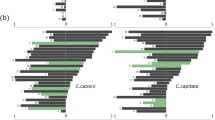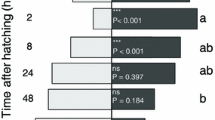Abstract
In field-cage studies, we investigated how the foraging behavior of tephritid fruit flies is modified by experience immediately prior to release on host plants. We observed females of a relatively monophagous species,Rhagoletis mendax (blueberry maggot fly), an oligophagous species,Rhagoletis pomomella (apple maggot fly), and a polyphagous species,Ceratitis capitata (Mediterranean fruit fly). Just prior to release on a host plant, the following kinds of stimuli were supplied: (1) single oviposition in a host fruit, (2) contact with 20% sucrose, (3) contact with a mixture of protein food (bird feces and sucrose), (4) contact with water, and (5) a walk over a host-plant leaf. When flies foraged on host plants without resources, search was most intensive (as measured by number of leaves visited) following a single oviposition in fruit, but residence time generally was the same following exposure to sugar, protein, and fruit stimuli.Rhagoletis mendax andC. capitata females visited the fewest leaves following exposure to water or host leaves, whereasR. pomonella foraged equally intensively following exposure to food stimuli, water, or leaves. On host plants containing resources (fruit and protein food), a single oviposition dramatically increased the number of females of all three species that found fruit compared to females that received experience with food, water or foliar stimuli. We found no significant effect of recent brief experience with any of the stimuli on subsequent attraction to protein food. Overall,C. capitata exhibited a higher propensity to abandon host plants than eitherR. mendax orR. pomonella. We suggest that this may reflect adaptations to differences in distribution of host plants in nature, strategies of dispersal, and host range.
Similar content being viewed by others
References
Averill, A. L., and Prokopy, R. J. (1993). Foraging ofRhagoletis pomonella flies in relation to interactive food and fruit resources.Entomol. Exp. Appl. 66: 179–185.
Bell, W. J. (1985). Sources of information controlling motor patterns in arthropod local search orientation.J. Insect Phys. 31: 837–847.
Bell, W. J. (1990). Searching behavior patterns in insects.Annu. Rev. Entomol. 35: 447–467.
Bell, W. J. (1991).Searching Behavior: The Behavioral Ecology of Finding Resources, Chapman and Hall, Cambridge University Press, New York.
Bressers, M., Meelis, E., Haccou, and Kruk, M. (1991). When did it really start or stop: The impact of censored observations on the analysis of duration.Behav. Proc. 23: 1–20.
Bush, G. L. (1966). The taxonomy, cytology and evolution of the genusRhagoletis in North America.Bull. Museum Comp. Zool. 134: 431–562.
Dethier, V. G. (1976).The Hungry Fly, Harvard University Press, Cambridge, MA.
Eskafi, F. M., and Kolbe, M. E. (1990). Infestation patterns of commonly cultivated, edible fruit species byCeratitis capitata andAnastrepha spp. (Diptera: Tephritidae) in Guatemala and their relationship to environmental factors.Environ. Entomol. 19: 1371–1380.
Harris, E. J., and Lee, C. Y. (1987). Seasonal and annual distribution of the Mediterranean fruit fly (Diptera: Tephritidae) in Honolulu and suburban areas of Oahu, Hawaii.Environ. Entomol. 16: 1273–1282.
Hemerik, L., Driessen, G., and Haccou. (1993). Effects of intra-patch experiences on patch time, search time and searching efficiency of the parasitoidLeptopilina clavipes.J. Anim. Ecol. 62: 33–44.
Hendrichs, J., and Hendrichs, M. A. (1990). Mediterranean fruit fly in nature: Location and diel pattern of feeding and other activities on fruiting and non-fruiting hosts and non-hosts.Ann. Entomol. Soc. Am. 83: 632–641.
Hendrichs, J., Katsoyannos, B. I., Papaj, D. R., and Prokopy, R. J. (1991). Sex differences in movement between natural feeding and mating sites and tradeoffs between food consumption, mating success and predator evasion in Mediterranean fruit flies.Oecologia 86: 223–231.
Hendrichs, J., Fletcher, B. S., and Prokopy, R. J. (1993). Feeding behavior ofRhagoletis pomonella flies (Diptera: Tephritidae): Effect of initial food quantity and quality on food foraging, handling costs, and bubbling.J. Insect. Behav. 6: 43–64.
Jones, R. E. (1976). Search behavior: a study of three caterpillar species.Behavior 60: 237–259.
Liquido, N. J., Cunningham, R. T., and Nakagawa, S. (1990). Host plants of Mediterranean fruit fly (Diptera: Tephritidae) on the island of Hawaii (1949–1985 survey).J. Econ. Entomol. 83: 1863–1878.
Malavasi, A., and Prokopy, R. J. (1992). Effect of food deprivation on the foraging behavior ofRhagoletis pomonella females for food and host fruit.J. Entomol. Sci. 27: 185–193.
Messina, F. J. (1989). Host preferences of cherry-and hawthorn-infesting populations ofRhagoletis pomonella in Utah.Entomol. Exp. Appl. 53: 89–95.
Nakamuta, K. (1985). Mechanism of the switchover from extensive to area-concentrated search behaviour of the ladybird beetle,Coccinella septempunctata Bruckii.J. Insect Physiol. 31: 849–856.
Papaj, D. R., and Prokopy, R. J. (1989). Ecological and evolutionary aspects of learning in phytophagous insects.Annu. Rev. Entomol. 34: 315–350.
Papaj, D. R., Prokopy, R. J., McDonald, P. T., and Wong, T. T. Y. (1987). Differences in learning between wild and laboratoryCeratitis capitata flies.Entomol. Exp. Appl. 45: 65–72.
Prokopy, R. J., McDonald, P. T., and Wong, T. T. Y. (1984). Interpopulation variation amongCeratitis capitata flies in host acceptance pattern.Entomol. Exp. Appl. 35: 65–69.
Prokopy, R. J., Kallet, C., and Cooley, S. S. (1985). Fruit acceptance pattern ofRhagoletis pomonella flies from different geographic regions.Ann. Entomol. Soc. Am. 78: 799–803.
Prokopy, R. J., Diehl, S. R., and Cooley, S. S. (1988). Behavioral evidence for host races inRhagoletis pomonella flies.Oecologia 76: 138–147.
Prokopy, R. J., Aluja, M., Papaj, D. R., Roitberg, B. D., and Wong, T. T. Y. (1989a). Influence of previous experience with host plant foliage on behavior of Mediterranean fruit fly females.Proc. Hawaii. Entomol. Soc. 29: 97–102.
Prokopy, R. J., Green, T. A., and Wong, T. T. Y. (1989b). Leraning to find fruit inCeratitis capitata flies.Entomol. Exp. Appl. 53: 65–72.
Prokopy, R. J., Papaj, D. R., Hendrichs, J., and Wong, T. T. Y. (1992). Behavioral responses ofCeratitis capitata flies to bait spray droplets and natural food.Entomol. Exp. Appl. 64: 247–257.
Prokopy, R. J., Roitberg, B. D., and Vargas, R. I. (1994a). Effects of egg load on finding and acceptance of host fruit inCeratitis capitata flies.Physiol. Entomol. 19: 124–132.
Prokopy, R. J., Cooley, S. S., Prokopy, J. J., Quan, Q., and Buonaccorsi, J. P. (1994b). Interactive effects of resource abundance and state of adults on residence of apple maggot (Diptera: Tephritidae) flies in host tree patches.Environ. Entomol. 23: 304–315.
Rice, W. R. (1989). Analyzing tables of statistical tests.Evolution 43: 223–225.
Roitberg, B. D., and Prokopy, R. J. (1984). Host visitation sequence as a determinant of search persistence in fruit parasitic tephritid flies.Oecologia 62: 7–12.
Roitberg, B. D., Lenteren, J. C. van, van Alphen, J. J. M., Galis, F., and Prokopy, R. J. (1982). Foraging behavior ofRhagoletis pomonella, a parasite of hawthorn (Crataegus viridis), in nature.J. Anim. Ecol. 51: 307–325.
Sokal, R. R., and Rohlf, F. J. (1981).Biometry, W. H. Freeman, San Francisco.
Vinson, S. B. (1977). Behavioral chemicals in the augmentation of natural enemies. In Ridgway, R. L., and Vinson, S. B. (eds.),Biological Control by Augmentation of Natural Enemies, Plenum Press, New York, pp. 237–279.
Author information
Authors and Affiliations
Rights and permissions
About this article
Cite this article
Averill, A.L., Prokopy, R.J., Sylvia, M.M. et al. Effects of recent experience on foraging in tephritid fruit flies. J Insect Behav 9, 571–583 (1996). https://doi.org/10.1007/BF02213881
Revised:
Issue Date:
DOI: https://doi.org/10.1007/BF02213881




